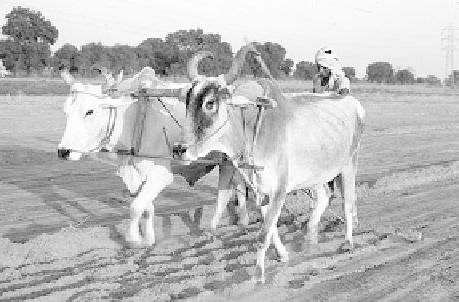Agriculture Reference
In-Depth Information
Pakistan, and China) have a limited market for fresh meat due to the lack of a refriger-
ated distribution system. This limits the meat to local markets. A second limiting factor
in India is the strong vegetarian tradition among Hindus, though buffaloes are not con-
sidered sacred, as are cows.
A third significant use of both cattle and buffaloes is for draft power. In most parts
of the developing world oxen, or bullocks, are an essential source of farm tillage power.
As can be seen in Figure 7.18, the hump behind the head is necessary to hold the yoke in
place for pulling loads. This develops in male animals after about 1 year of age. They
are then castrated, or neutered, to maintain a docile temperament.
In parts of Africa the presence of draft animals is limited by the presence of trypa-
nosomiasis. This parasite, carried by the tsetse fly, is fatal to cattle. Several important
diseases are also carried by cattle ticks. These problems have limited the spread of draft
animals in sub-Saharan Africa. As a result, much of the tillage of agricultural lands is
done by hand labor.
Animals for draft purposes have the advantage of being a renewable energy
source and provide manure as fertilizer, milk, beef, and hides. When born on the
farm, their initial cost is minimal compared to a tractor. A problem is that work
animals are not needed for field work during most months of the year. Unlike a
tractor, they must be fed and cared for even though they do no useful work. As a
result, the farmer tends to ignore the animals during periods when feed is lacking
and work is not needed.
7.5.3 Pests and Diseases
The OIE list A diseases affecting cattle and buffaloes are described here. The OIE
method of classifying diseases is covered in Section 7.4.6.
Foot-and-Mouth Disease.
Foot-and-mouth disease (FMD) is a highly conta-
gious virus disease of cloven-hoofed animals. Those most affected are cattle, buffaloes,
Figure
7.18.
Bullocks in India.









